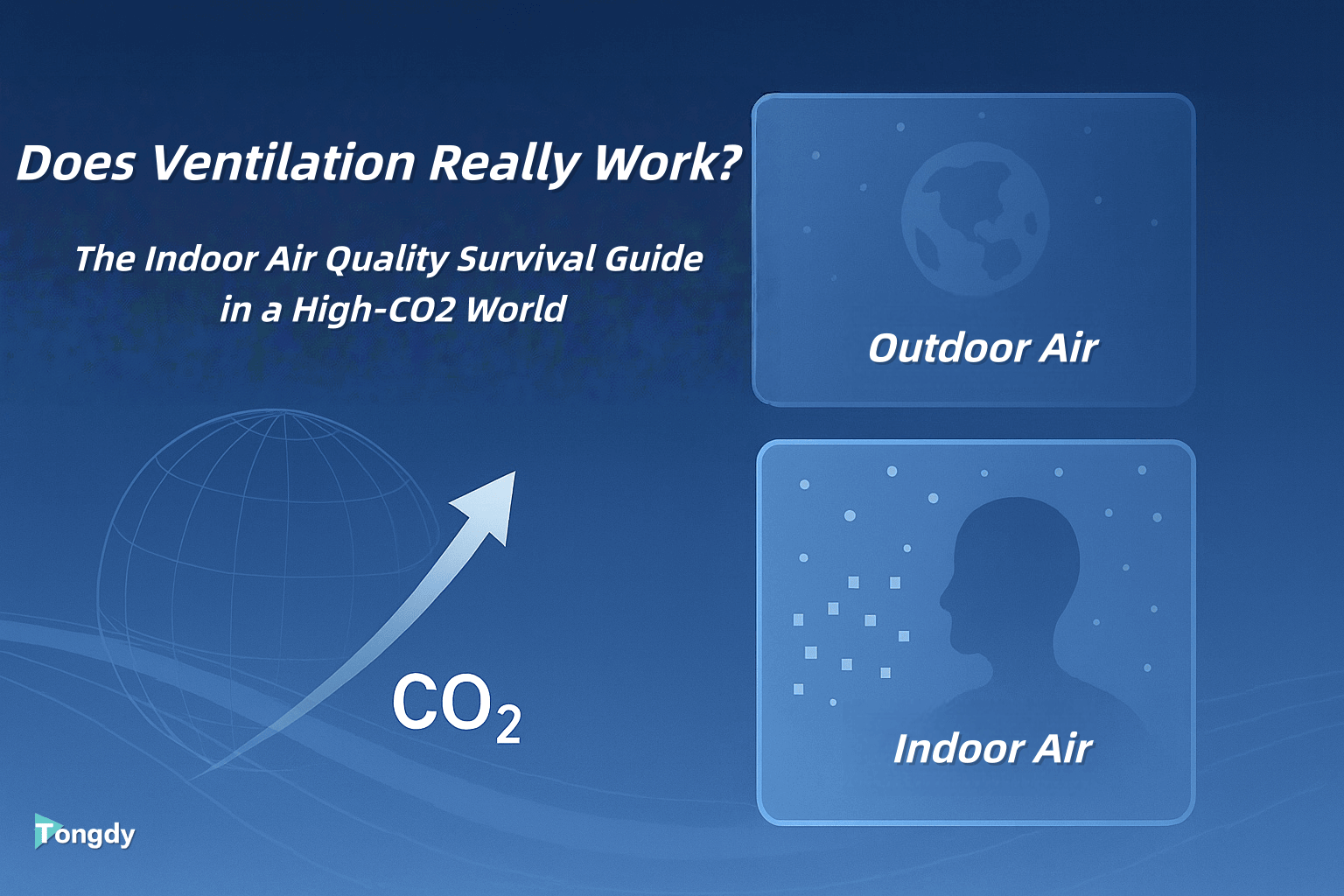1. Global CO2 Hits Record Highs — But Don't Panic: Indoor Air Is Still Manageable
According to the World Meteorological Organization (WMO) Greenhouse Gas Bulletin, October 15, 2025, global atmospheric CO2 reached a historic high of 424 ppm in 2024, rising 3.5 ppm in one year — the largest jump since 1957.
It may sound a bit alarming, but don’t mix up these two concepts.
|
Item |
Meaning |
Health Impact |
|
Global CO2 concentration |
Average CO2 concentration in the global atmosphere (~424 ppm) |
Affects the climate system and contributes to global warming |
|
Indoor CO2 concentration |
CO2 concentration in enclosed spaces (classrooms, offices, etc.) caused by respiration and poor ventilation (commonly 1500–2000 ppm) |
Affects comfort levels, concentration, and cognitive performance |
Even with global CO2 rising, simple ventilation or fresh-air systems can cut indoor CO2 levels from 1,500 ppm to around 700–800 ppm, dramatically improving health and productivity.
2. High CO2 Doesn't Poison You — It Slows You Down
Scientific studies show:
|
CO2 Level |
Condition |
Effects on People |
|
400–800 ppm |
Fresh air |
Focused, clear thinking |
|
800–1200 ppm |
Slightly stuffy |
Drowsy, less attentive |
|
1200–2000 ppm |
Uncomfortable |
Headache, fatigue, lower performance |
|
>2500 ppm |
Significant impact |
Cognitive decline >30%, dizziness |
Data from Harvard School of Public Health and ASHRAE reveal that drowsiness in long meetings or classrooms often signals excessive indoor CO2.
3. Ventilation Still Works — And It’s More Important Than Ever
Despite rising global CO2, outdoor air is still cleaner than stale indoor air. Ventilation does far more than “just move air.”
The Five Health Benefits of Ventilation
|
Function |
Improvement |
Benefits |
|
Dilutes exhaled CO2 |
lowers indoor CO2 |
reduces fatigue, boosts focus |
|
Removes pollutants |
VOCs, and formaldehyde |
Prevents irritation, headaches |
|
Limits pathogen spread |
Aerosols, and viruses |
Reduces infection risk |
|
Balances heat & humidity |
Comfort control |
Prevents mold, stuffiness |
|
Enhances mental well-being |
Fresh air flow |
reduces anxiety, and improves mood |

4. Smart Ways to Ventilate--Energy-Efficient and Healthy
1️⃣ Demand-Controlled Ventilation (DCV): Sensors adjust airflow automatically when CO2 rises-saving energy while maintaining fresh air.
2️⃣ Energy Recovery Ventilation (ERV/HRV): Exchanges indoor and outdoor air while recovering heat or humidity to cut HVAC costs.
3️⃣ Smart Monitoring + Visualization:
Use Tongdy CO2 and IAQ sensors for real-time tracking of CO2, PM2.5, TVOC, temperature, and humidity. Integrated with BMS systems, these devices enable automatic control in schools, offices, hospitals, hotels, and senior facilities.
5. Tongdy: Making Air Visible, Manageable, and Optimizable
Tongdy specializes in indoor air environment monitoring, offering real-time data on:
Particulates: PM2.5, PM10, PM1.0
Gases: CO2, TVOC, CO, O3, HCHO
Comfort: Temperature, humidity, noise, light
Supports RS-485, Wi-Fi, LoRaWAN, Ethernet, and multiple protocols.
Cloud-based dashboards provide visualization and alert automation — turning air quality into a building health dashboard across commercial and public spaces.
6. FAQ — What People Often Ask
Q1: With global CO2 this high, does ventilation still matter?
A: Yes. Outdoor CO2 ≈ 424 ppm; indoor levels often hit 1,500 ppm. Ventilation restores safe levels.
Q2: Is opening windows enough?
A: Natural ventilation helps, but weather and pollution limit it. Mechanical fresh-air systems with monitoring are ideal.
Q3: Do air purifiers reduce CO2?
A: No. Purifiers filter particles, not gases. CO2 must be reduced by ventilation or plants.
Q4: What level is “too high”?
A: Over 1,000 ppm signals poor ventilation; 1,500 ppm means serious stagnation.
Q5: Why do schools and offices install CO2 monitors?
A: Crowded, enclosed spaces accumulate CO2 quickly. Continuous monitoring ensures healthy, productive environments.
7. Final Word: Air Is Invisible, But Never Irrelevant
A healthy indoor environment requires scientific air management. From “breathing buildings” to smart air monitoring systems, technology and data are redefining what it means to breathe well — every single day.
References:
World Meteorological Organization (WMO), Greenhouse Gas Bulletin 2024
ASHRAE, Position Document on Indoor CO2 and IAQ
Post time: Oct-29-2025
